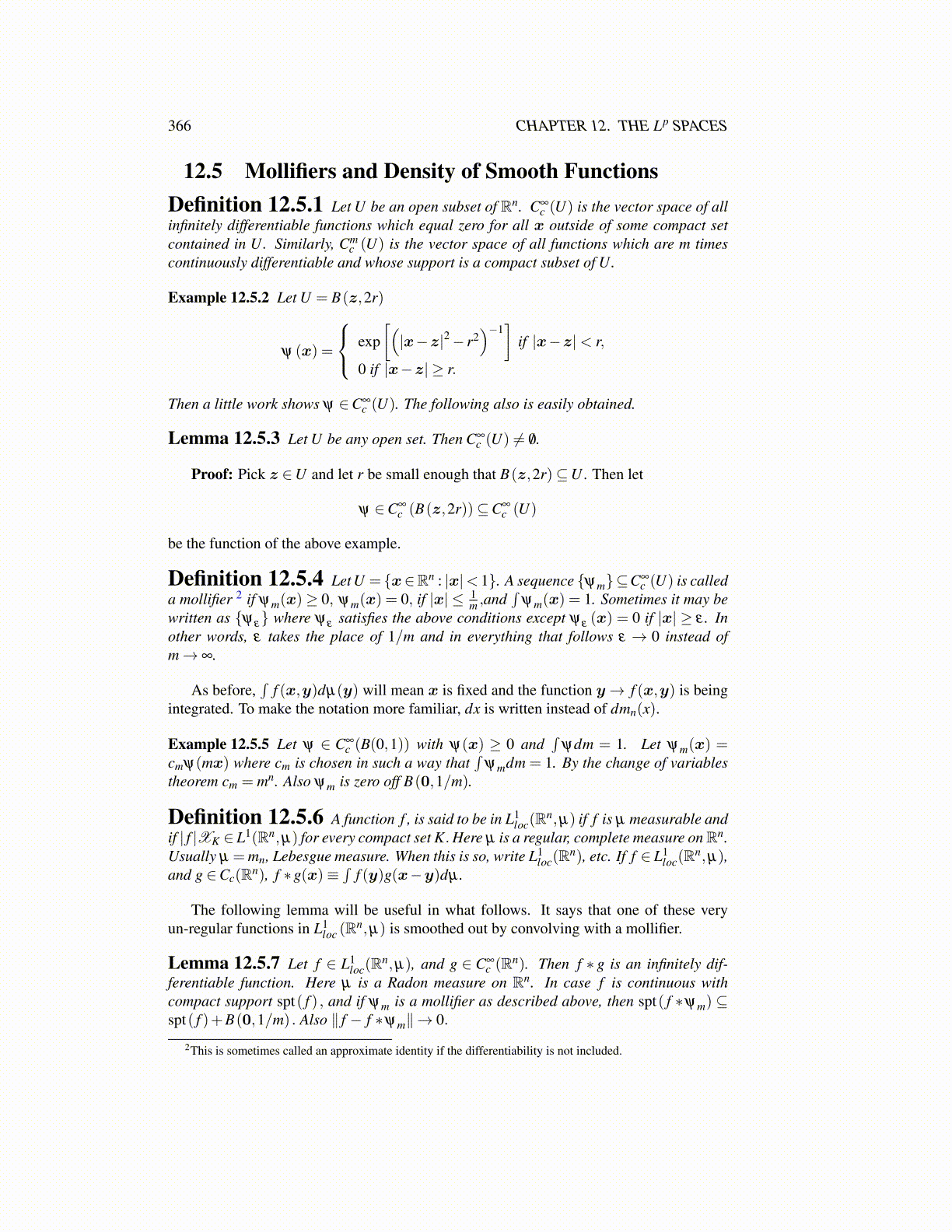
366 CHAPTER 12. THE Lp SPACES
12.5 Mollifiers and Density of Smooth FunctionsDefinition 12.5.1 Let U be an open subset of Rn. C∞
c (U) is the vector space of allinfinitely differentiable functions which equal zero for all x outside of some compact setcontained in U. Similarly, Cm
c (U) is the vector space of all functions which are m timescontinuously differentiable and whose support is a compact subset of U.
Example 12.5.2 Let U = B(z,2r)
ψ (x) =
exp[(|x−z|2− r2
)−1]
if |x−z|< r,
0 if |x−z| ≥ r.
Then a little work shows ψ ∈C∞c (U). The following also is easily obtained.
Lemma 12.5.3 Let U be any open set. Then C∞c (U) ̸= /0.
Proof: Pick z ∈U and let r be small enough that B(z,2r)⊆U . Then let
ψ ∈C∞c (B(z,2r))⊆C∞
c (U)
be the function of the above example.
Definition 12.5.4 Let U = {x∈Rn : |x|< 1}. A sequence {ψm}⊆C∞c (U) is called
a mollifier 2 if ψm(x)≥ 0, ψm(x) = 0, if |x| ≤ 1m ,and
∫ψm(x) = 1. Sometimes it may be
written as {ψε} where ψε satisfies the above conditions except ψε (x) = 0 if |x| ≥ ε . Inother words, ε takes the place of 1/m and in everything that follows ε → 0 instead ofm→ ∞.
As before,∫
f (x,y)dµ(y) will mean x is fixed and the function y→ f (x,y) is beingintegrated. To make the notation more familiar, dx is written instead of dmn(x).
Example 12.5.5 Let ψ ∈ C∞c (B(0,1)) with ψ(x) ≥ 0 and
∫ψdm = 1. Let ψm(x) =
cmψ(mx) where cm is chosen in such a way that∫
ψmdm = 1. By the change of variablestheorem cm = mn. Also ψm is zero off B(0,1/m).
Definition 12.5.6 A function f , is said to be in L1loc(Rn,µ) if f is µ measurable and
if | f |XK ∈ L1(Rn,µ) for every compact set K.Here µ is a regular, complete measure onRn.Usually µ =mn, Lebesgue measure. When this is so, write L1
loc(Rn), etc. If f ∈ L1loc(Rn,µ),
and g ∈Cc(Rn), f ∗g(x)≡∫
f (y)g(x−y)dµ .
The following lemma will be useful in what follows. It says that one of these veryun-regular functions in L1
loc (Rn,µ) is smoothed out by convolving with a mollifier.
Lemma 12.5.7 Let f ∈ L1loc(Rn,µ), and g ∈ C∞
c (Rn). Then f ∗ g is an infinitely dif-ferentiable function. Here µ is a Radon measure on Rn. In case f is continuous withcompact support spt( f ) , and if ψm is a mollifier as described above, then spt( f ∗ψm) ⊆spt( f )+B(0,1/m) . Also ∥ f − f ∗ψm∥→ 0.
2This is sometimes called an approximate identity if the differentiability is not included.